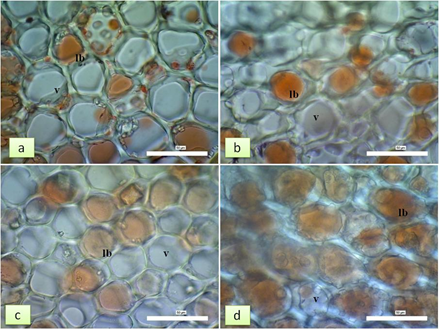
Histochemistry of backcross 1 of oil palm seeds at different storage periods
Ernayunita Ernayunita(1*), Taryono Taryono(2), Prapto Yudono(3)
(1) Scholar, South East Asia Research for Agriculture (SEARCA) Los Banos 4031, Laguna, Philippines Department of Plant Breeding and Biotechnology, Indonesian Oil Palm Research Institute, Jl. Brigjen Katamso 51, Medan 20158, Indonesia Department of Agronomy, Faculty of Agriculture, Universitas Gadjah Mada Jln. Flora, Bulaksumur, Sleman, Yogyakarta 55281, Indonesia
(2) Department of Agronomy, Faculty of Agriculture, Universitas Gadjah Mada Jln. Flora, Bulaksumur, Sleman, Yogyakarta 55281, Indonesia Agrotechnology Innovation Centre, Universitas Gadjah Mada, Jl. Tanjung Tirto, Kali Tirto Berbah Sleman, Yogyakarta, Indonesia
(3) Department of Agronomy, Faculty of Agriculture, Universitas Gadjah Mada Jln. Flora, Bulaksumur, Sleman, Yogyakarta 55281, Indonesia
(*) Corresponding Author
Abstract
Oil palm backcross 1 is the result of the crossing between Elaeis oleifera and Elaeis guineensis, followed by backcrossing to one of its parents. It has several advantages, including slow height growth and good oil quality, thereby having the potential to be developed. However, it also has a short seed shelf life, which might be inherited from E. oleifera that has relatively quick seed deterioration. This is problem to the breeding program, and there have not been many studies on the seed deterioration process. A histological examination can determine the composition of food reserves in seed endosperm tissue. Therefore, it is necessary to assess the histochemistry of seeds concerning the process of seed deterioration. Histochemical tests with Sudan III, Milon, and IKI reagents were used as histochemical tests of fat, protein and carbohydrate seed content with different seed storage periods, i.e. 4, 3, 2, and less than 1 year. The result showed that the fat content decreased during the storage periods. Based on carbohydrates and proteins staining, there were only very few substances , which were difficult to distinguish among the storage periods, so that this analysis could not be used as the determining indicator of seed deterioration. The fat content was a determining factor of seed deterioration and quality. The oil palm seed storage up to 3-4 years led to the reduction in the fat content in significant quantities compared to the fresh seeds stored less than 1 year as they still contained a lot of fat in the cell.
Keywords
Full Text:
PDFReferences
Aslam, J., S.A. Khan, A.J. Cheruth, A. Mujib, M.P. Sharma, and P.S. Srivastava. 2011. Somatic embryogenesis, scanning electron microscopy, histology and biochemical analysis at different developing stages of embryogenesis in six date palm (Phoenix dactylifera L.) cultivars. Saud.J.Biol., 18:369-380.
Bewley, J.D. and M. Black. 1985. Seed Phisiology of Development and Germination. 2th ed., New York: Plenum Press.
Bewley, J.D.; K.J. Bradford; H.W.M. Hilhorst and H. Nonogaki. 2013. Physiology of Development, Germination and Dormancy. 3th ed., New York: Springer.
Corley, R.H.V. and P.B. Tinker. 2016. The Oil Palm. 4th ed., Oxford: Blackwell Science Ltd.
Dangou, J. S., V. Hocher, N. Ferrière, C. Fulcheri, P. Morard and L. Alemanno. 2002. Histological and biochemical characterization of Theobroma cacao L. endosperm during seed development. Seed Science Research., 12: 91-100.
Hong, T.D.; S. Linington and R.H. Ellis. 1996. Handbooks for Gene Bank, Seed Storage Behavior: Compendium. 4th ed., Italy: International Plant Genetic Resources Institute.
Iossi, E., F.V. Moro, B.G.T.L. Vieira, R.M. Barbosa, and R.D. Vieira. 2016. Chemical composition and tetrazolium test of Syagrus romanzoffiana (Cham.) Glassman Seeds. Rev. Bras. Frutic. Jaboticabal-SP., 38:1-10.
Jensen, W.A. 1962. Botanical Histochemistry Principles and Practice. 1th ed., San Fransisco: W.H. Freeman and Company.
Karneta, R., K. Delita, and B. Indrata. 2017. The viability of oil palm seeds during storage and heating. Int. J. Engg. Res. & Sci. & Tech., 6:1-11.
Kiernan, J.A. 2017. Carbohydrate Histochemistry. https://www.researchgate.net/publication/288929542.
Kok, S.Y., P. Namasivayam, GC-L. Ee, and M. Ong-Abdullah. 2013. Biochemical characterization during seed development of oil palm (Elaeis guineensis). J. Plant Res., 126:539-547.
Kok, S.Y., M. Ong-Abdullah, G. Cheng-Lian Ee, and P. Namasivayam. 2015. A histological study of oil palm (Elaeis guineensis) endosperm during seed development. Journal of Oil Palm Research., 27:107-112.
Moura, E.F., M.C. Ventrella, and S.Y. Motoike. 2010. Anatomy, histochemistry, and ultrastructure of seed and somatic embryo of Acrocomia aculeate (Arecaceae). Sci. Agric. (Piracicaba, Braz)., 67:399-407.
Morello, J.R., M.J. Motilva, M.J. Tovar, and M.P. Romero. 2004. Changes in commercial virgin olive oil (cv Arbequina) duringstorage, with special emphasis on the phenolic fraction. Food Chemistry., 85:357-364.
Montoya, C., R. Rivallan, A.M. Risterucci, D. Bittencourt, J. R. Zambrano, W.H. Alarcón, P. Villeneuve, M. Pina, B. Nouy, P. Amblard, E. Ritter, T. Leroy, and N. Billotte. 2013. Quantitative trait loci (QTLs) analysis of palm oil fatty acid composition in an interspecific pseudo-backcross from Elaeis oleifera (H.B.K.) Cortés and oil palm (Elaeis guineensis Jacq.). Tree Genetics and Genomes., 9:1207-1225.
Norziha, A., M. Marhalil, A.M. Fadila, Y. Zulkifli, I. Maizura, M.A. Din, N. Rajanaidu, and A. Khusairi. 2017. Long-term storage of oil palm germplasm zygotic embryo using cryopreservation. Journal of Oil Palm Research., 29:541-547.
Panza, V., V. Lainez, and S. Maldonado. 2004. Seed structure and histochemistry in the palm Euterpe edulis. Bot. J. Linn. Soc., 145:445-453.
Setiawan, K. 2017. Pemuliaan kelapa sawit untuk produksi benih unggul: Tanaman pendek, kompak, dan minyak tak jenuh tinggi.1st ed. Yogyakarta: Plantaxia.
Shaban, M. 2013. Review on physiological aspects of seed deterioration. Intl. J. Agri. Crop. Sci., 6:627-63.
Zafra, A., M. M’rani-Alaour, E. Lima, J.C. Jimenez-Lopez, and J.D. Alche. 2018. Histological features of the olive seed and presence of 7S-type seed storage proteins as hallmarks of the olive fruit development. Front Plant. Sci., 9:1-15.Article Metrics
Refbacks
- There are currently no refbacks.
Ilmu Pertanian (Agricultural Science) ISSN 0126-4214 (print), ISSN 2527-7162 (online) is published by Faculty of Agriculture Universitas Gadjah Mada collaboration with Perhimpunan Sarjana Pertanian Indonesia (PISPI) and licensed under a Creative Commons Attribution-ShareAlike 4.0 International License.












_2025_-_kecil_.png)
_2024_kecil_2.png)
